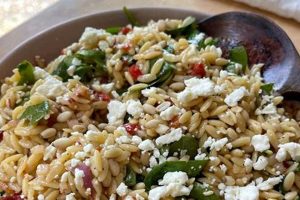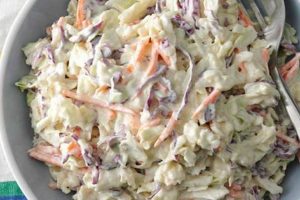A Caesar salad, traditionally known for its rich, creamy dressing and croutons, can be adapted to fit health-conscious diets. Modifications focus on reducing overall fat and calorie content while maintaining the signature flavors of this classic dish. This involves using lighter ingredients and alternative preparation methods. For instance, Greek yogurt or a low-fat mayonnaise base can replace traditional Caesar dressing ingredients, while whole-wheat croutons baked instead of fried offer a satisfying crunch with fewer calories.
Healthier versions offer the opportunity to enjoy a beloved dish without compromising dietary goals. Caesar salad, originally created in the 1920s, has become a staple menu item. However, its traditional preparation often results in high caloric and fat content. Adapting the recipe provides a more nutritious option, particularly for individuals managing weight or cholesterol levels. Lighter versions retain the satisfying combination of romaine lettuce, Parmesan cheese, and flavorful dressing, making it a versatile and enjoyable component of a balanced diet.
The following sections will explore specific strategies and ingredients for creating delicious and healthy Caesar salad variations. These include alternative dressing recipes, healthy crouton options, and tips for adding protein and other nutrients to create a complete and satisfying meal.
Tips for Creating a Healthier Caesar Salad
Creating a satisfying and nutritious Caesar salad while minimizing caloric intake involves strategic ingredient selection and preparation methods. The following tips offer guidance for achieving this balance.
Tip 1: Reimagine the Dressing. Traditional Caesar dressing relies heavily on oil, egg yolks, and cheese. A lighter version can be achieved by using Greek yogurt or low-fat mayonnaise as a base. Lemon juice, garlic, and anchovy paste or Worcestershire sauce contribute the signature Caesar flavor without excess calories.
Tip 2: Opt for Whole-Wheat Croutons. Croutons add a desirable crunch but can be calorie-dense. Whole-wheat bread, cut into small cubes and baked with a light coating of olive oil, offers a healthier and equally satisfying alternative to fried croutons.
Tip 3: Embrace Romaine Hearts. Romaine lettuce provides a crisp foundation for the salad. Using romaine hearts minimizes the tougher outer leaves and maximizes the tender, flavorful inner portion.
Tip 4: Portion Control Parmesan. Parmesan cheese delivers a sharp, salty flavor, but its caloric contribution can be significant. Grating Parmesan finely allows for even distribution and a pronounced taste with less cheese.
Tip 5: Boost Nutritional Value. Adding grilled chicken breast, fish, or chickpeas enhances the protein content and creates a more substantial meal. These additions contribute to satiety and overall nutritional value.
Tip 6: Explore Alternative Greens. While romaine is traditional, consider incorporating other nutrient-rich greens like kale or spinach for added vitamins and minerals.
Tip 7: Mindful Ingredient Additions. Avocados, while healthy, are calorie-dense. Use them sparingly or opt for less calorically dense vegetables like bell peppers or cucumbers.
By incorporating these strategies, individuals can enjoy the classic flavors of a Caesar salad while prioritizing health and well-being. A well-balanced and flavorful meal can be achieved without sacrificing satisfaction.
These tips provide a foundation for exploring various healthy Caesar salad variations. The following section will offer specific recipe ideas and further guidance for crafting personalized versions.
1. Reduced-fat Dressing
Reduced-fat dressing plays a crucial role in achieving a truly low-calorie Caesar salad. Traditional Caesar dressings, often rich in oil, egg yolks, and cheese, contribute significantly to the overall calorie count. Substituting a reduced-fat alternative drastically lowers the caloric impact while maintaining the essential creamy texture and tangy flavor profile.
- Calorie Reduction
The primary benefit of a reduced-fat dressing lies in its significant calorie reduction compared to traditional versions. This reduction can range from 30% to 50% or more, depending on the specific ingredients and preparation methods. For individuals monitoring calorie intake, this difference can be substantial, allowing enjoyment of a Caesar salad without exceeding dietary limitations.
- Ingredient Alternatives
Reduced-fat dressings achieve their lower calorie content through strategic ingredient substitutions. Greek yogurt, low-fat mayonnaise, and even pureed avocado can replace higher-fat components like heavy cream and oil. These alternatives offer a similar creamy consistency while contributing fewer calories and often adding nutritional value.
- Flavor Enhancement Techniques
Maintaining flavor complexity in a reduced-fat dressing often requires enhancing other flavor components. Increased use of lemon juice, garlic, Dijon mustard, and spices like black pepper can compensate for the reduced richness from fat. Anchovy paste or Worcestershire sauce can provide the umami notes characteristic of traditional Caesar dressings.
- Impact on Overall Health
Beyond calorie reduction, opting for a reduced-fat dressing can contribute to overall health. Lower fat intake can benefit cardiovascular health and weight management. Additionally, ingredient alternatives like Greek yogurt introduce beneficial probiotics and protein.
By strategically incorporating a reduced-fat dressing, a Caesar salad transforms from a calorie-dense indulgence into a healthful and satisfying meal option. This crucial modification allows individuals to enjoy the classic flavors of a Caesar salad while aligning with dietary goals and promoting overall well-being.
2. Whole-wheat Croutons
Whole-wheat croutons represent a significant opportunity for calorie reduction within a Caesar salad. Traditional croutons, typically prepared from white bread and fried in oil, contribute substantial calories and fat. Substituting whole-wheat croutons, particularly those baked rather than fried, offers a comparable textural element while significantly lowering caloric and fat content. This substitution aligns with the goals of a low-calorie Caesar salad recipe by minimizing unnecessary caloric intake without sacrificing the desirable crunch and flavor contribution of croutons. For example, replacing one ounce of fried croutons with an equivalent amount of baked whole-wheat croutons can save approximately 40-50 calories. This seemingly small change can accumulate significant caloric savings over time and within the context of an entire meal.
The benefits of whole-wheat croutons extend beyond calorie reduction. Whole-wheat flour offers a higher fiber content compared to refined white flour. Increased dietary fiber contributes to satiety, aiding in portion control and potentially supporting weight management efforts. Whole-wheat croutons also provide a modest increase in micronutrient intake compared to their white bread counterparts. While these nutritional differences may be subtle, they contribute to the overall healthfulness of the modified Caesar salad. Furthermore, the slightly denser texture and nuttier flavor of whole-wheat bread can complement the other flavors within the salad, creating a more complex and satisfying sensory experience.
In conclusion, the incorporation of whole-wheat croutons serves as a practical and effective strategy for creating a truly low-calorie Caesar salad. This simple substitution yields meaningful caloric reductions while enhancing nutritional value and potentially improving satiety. Careful consideration of crouton preparation methods, specifically opting for baking over frying, further maximizes the health benefits and aligns with the overall objective of creating a lighter, more nutritious version of this classic dish. This attention to detail contributes meaningfully to the broader aim of achieving a balanced and healthful dietary pattern.
3. Lean Protein Additions
Lean protein additions play a vital role in transforming a low-calorie Caesar salad from a side dish into a complete and satisfying meal. Protein promotes satiety, contributing to feelings of fullness and reducing the likelihood of overeating. In the context of a calorie-conscious diet, this becomes particularly crucial, as it helps manage hunger and supports weight management goals. Furthermore, protein provides essential amino acids necessary for muscle maintenance and repair, making it a valuable addition to any balanced diet.
- Enhanced Satiety
Protein exerts a more pronounced effect on satiety compared to carbohydrates or fats. Adding lean protein to a low-calorie Caesar salad increases its filling power, helping individuals feel satisfied with smaller portions. This effect can be particularly beneficial for those seeking to manage calorie intake without experiencing persistent hunger.
- Nutrient Density
Lean protein sources, such as grilled chicken breast, fish, or tofu, contribute essential nutrients beyond just protein. These options offer varying combinations of vitamins, minerals, and healthy fats, enhancing the overall nutritional profile of the salad. For instance, grilled salmon provides omega-3 fatty acids, while chicken breast contributes niacin and selenium.
- Versatility and Flavor Pairing
Lean protein additions offer significant versatility within a low-calorie Caesar salad framework. Grilled or baked chicken, fish, shrimp, or plant-based options like tofu or tempeh can be seamlessly integrated. These additions can be seasoned and prepared in various ways to complement the Caesar flavors, enhancing both the nutritional and culinary experience.
- Metabolic Benefits
Protein requires more energy to digest compared to carbohydrates or fats, contributing to a slightly higher thermic effect of food. While this effect is relatively modest, it can contribute to overall energy expenditure. Additionally, adequate protein intake supports muscle mass maintenance, which is important for metabolic health.
Incorporating lean protein into a low-calorie Caesar salad elevates it from a simple salad to a nutritionally complete and satisfying meal. This strategic addition supports weight management goals by promoting satiety, contributes essential nutrients, and offers culinary versatility. By thoughtfully selecting and preparing lean protein sources, individuals can maximize the health benefits and enjoyment of this adapted classic dish.
4. Portion Control
Portion control plays a critical role in managing calorie intake within the context of a low-calorie Caesar salad recipe. Even with healthy ingredient substitutions, consuming excessive quantities can negate the intended caloric reduction. Understanding and implementing effective portion control strategies is essential for achieving the desired health benefits and maintaining a balanced diet.
- Dressing Measurement
Careful measurement of dressing is paramount. While a reduced-fat dressing offers fewer calories, overdressing can still contribute significantly to the overall calorie count. Using measuring spoons or a small ladle ensures consistent and controlled portions, preventing unintentional caloric excess. A typical serving size for salad dressing is one to two tablespoons. Exceeding this amount, even with a reduced-fat option, can quickly add unnecessary calories.
- Crouton Management
Croutons, even whole-wheat versions, contribute calories. Limiting crouton quantity prevents excess calorie consumption. Pre-portioning croutons into individual servings helps maintain control and prevents mindless snacking. A reasonable portion of croutons for a low-calorie salad is typically one-quarter to one-half cup. Visualizing this amount can assist in accurately estimating portion sizes.
- Cheese Allocation
Cheese, particularly Parmesan, adds flavor but also calories. Grating cheese finely and using a measured amount ensures flavor impact without excessive caloric contribution. Pre-portioning grated cheese helps maintain consistent serving sizes. A typical serving of Parmesan cheese is around one tablespoon. Distributing this amount evenly over the salad maximizes flavor perception while controlling caloric intake.
- Mindful Assembly
Mindful assembly of the salad itself contributes to portion control. Using smaller plates or bowls can create the illusion of a larger portion, promoting satisfaction with less food. Arranging the salad ingredients thoughtfully, rather than simply tossing them together, can also enhance visual appeal and promote a sense of fullness. This approach encourages a more mindful eating experience and facilitates portion awareness.
Effective portion control strategies are integral to the success of a low-calorie Caesar salad recipe. Careful attention to dressing, croutons, cheese, and overall salad assembly ensures that calorie-conscious ingredient choices translate into tangible caloric reduction. These practices support weight management goals and contribute to a balanced and healthful dietary pattern. Integrating these portion control techniques empowers individuals to enjoy the flavors of a Caesar salad while adhering to dietary guidelines and promoting overall well-being.
5. Fresh, Crisp Romaine
Fresh, crisp romaine lettuce forms the foundation of a successful low-calorie Caesar salad. Its structural integrity provides a satisfying crunch and volume, contributing to a sense of fullness without adding significant calories. Romaine’s relatively neutral flavor profile complements the assertive flavors of the Caesar dressing and other components, creating a balanced and harmonious culinary experience. A salad built on wilted or limp lettuce lacks textural appeal and can diminish the overall enjoyment of the dish, potentially leading to overconsumption of other, more calorie-dense ingredients. For instance, using fresh, crisp romaine allows for a larger salad volume with fewer calories compared to using a denser, less structurally sound lettuce variety, such as iceberg. This difference can be significant when aiming to manage calorie intake effectively.
Beyond its textural and flavor contributions, romaine lettuce offers nutritional value. It provides essential vitamins, minerals, and dietary fiber. These nutrients contribute to overall health and well-being, aligning with the broader objectives of a calorie-conscious diet. Specifically, romaine is a good source of Vitamin A and Vitamin K, both of which play important roles in maintaining healthy bodily functions. Incorporating fresh, high-quality romaine maximizes the nutritional benefits of the salad, further enhancing its value within a balanced dietary pattern. Moreover, the visual appeal of fresh, vibrant romaine enhances the sensory experience of consuming the salad, promoting a greater sense of satisfaction and enjoyment.
Selecting and preparing fresh romaine lettuce is crucial for optimizing its contribution to a low-calorie Caesar salad. Proper storage, washing, and drying techniques maintain the lettuce’s crispness and prevent premature wilting. Torn or chopped romaine should be used immediately after preparation to maximize its textural appeal. Any compromised leaves should be discarded to ensure optimal quality and prevent the inclusion of less palatable elements within the salad. Attention to these details elevates the final product and reinforces the importance of fresh, crisp romaine as a cornerstone of a successful and satisfying low-calorie Caesar salad.
Frequently Asked Questions
This section addresses common inquiries regarding low-calorie Caesar salad recipes, offering practical guidance for recipe adaptation and ingredient selection.
Question 1: How can traditional Caesar dressing be modified to reduce calories?
Calorie reduction in Caesar dressing primarily involves replacing high-fat ingredients. Greek yogurt, low-fat mayonnaise, or even pureed avocado can substitute for traditional oil and egg yolks. Flavor can be maintained through increased use of lemon juice, garlic, and spices.
Question 2: What are suitable alternatives to traditional croutons for minimizing caloric intake?
Whole-wheat bread, cut into small cubes and baked, provides a healthier alternative to fried croutons. Seasoning with herbs and spices enhances flavor while minimizing added calories from fat.
Question 3: Beyond romaine lettuce, what other greens can be incorporated into a low-calorie Caesar salad?
Nutrient-rich greens like kale, spinach, or arugula can complement or replace romaine, adding nutritional value and flavor complexity.
Question 4: How can portion control be effectively implemented when preparing a low-calorie Caesar salad?
Utilizing measuring tools for dressing and cheese, pre-portioning croutons, and serving the salad on smaller plates aids in managing portion sizes and overall calorie consumption.
Question 5: What are effective strategies for adding protein to a low-calorie Caesar salad without significantly increasing calories?
Grilled chicken breast, fish, shrimp, or plant-based options like chickpeas or tofu offer substantial protein with minimal caloric impact.
Question 6: How can overall flavor be enhanced in a low-calorie Caesar salad despite ingredient modifications?
Fresh herbs, spices, lemon zest, and a small amount of high-quality Parmesan cheese contribute significant flavor without substantial caloric additions.
Careful attention to ingredient selection, portion control, and flavor balancing allows for the creation of a truly satisfying and healthful Caesar salad. These strategies empower individuals to enjoy a beloved classic while adhering to dietary goals.
Further exploration of specific recipe variations and detailed nutritional information follows in the next section.
Conclusion
Exploration of low-calorie Caesar salad recipes reveals the potential for enjoying this classic dish while adhering to health-conscious dietary practices. Strategic modifications to traditional ingredients and preparation methods yield significant reductions in calorie and fat content without sacrificing flavor or satisfaction. Emphasis on reduced-fat dressings, whole-wheat croutons, lean protein additions, and portion control empowers individuals to create nutritious and flavorful versions of this culinary staple. Careful consideration of ingredient quality, particularly the freshness of romaine lettuce, further enhances the sensory experience and nutritional value.
The adaptability of the Caesar salad demonstrates that healthful eating does not necessitate the exclusion of beloved dishes. Rather, informed choices and creative culinary adaptations allow for the continued enjoyment of classic flavors within the context of a balanced and nutritious diet. This approach fosters a sustainable and positive relationship with food, promoting both physical well-being and culinary satisfaction.






